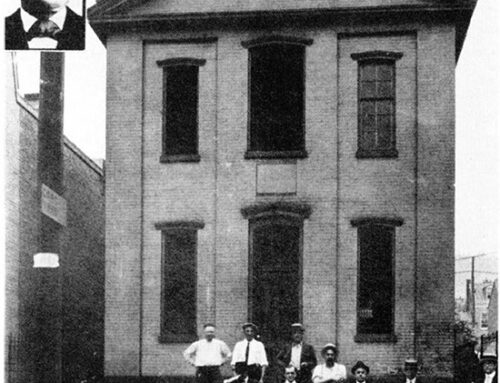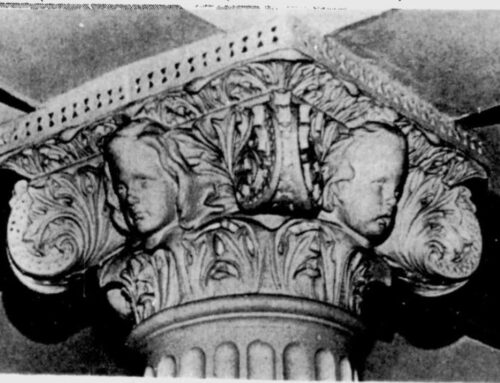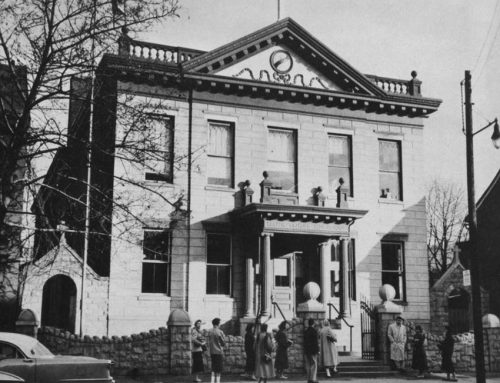Many of the new immigrants, particularly in the second half of the nineteenth century, were from Poland and were looking for a new land with religious and civil freedoms. Pennsylvania would be the land of opportunity for many immigrants, some of whom would settle in the anthracite “Coal Regions” of the state, and find work in the mines. One such area included the town of Mt. Carmel in Northumberland County. With an ever-increasing Polish population, and with the establishment of Catholic parishes and schools, the call was sent to Europe for women religious to staff the new schools.
One such request was made by Father Thaddeus Jackimowicz, a pastor in Mt. Carmel. Four Bernardine Sisters and Mother Veronica Grzedowska from Poland answered this call and arrived in New York Harbor aboard the steamship Ems on October 16, 1894. The sisters stayed at St. Stanislaus Rectory in New York under the kindness of Father Strzelecki until they met Father Jachimowicz for the train trip to Mt. Carmel, PA. Upon arriving in Mt. Carmel, the sisters stayed in the rectory until their convent was ready, and immediately began to teach in the parish school that numbered about 300 students. Language was an issue for both the sisters and the students, and for that reason, English was taught by a lay teacher, as both the students and the sisters learned a new language.
Unfortunately, the parish did not meet the conditions that the sisters agreed to before staffing the school. Mother Veronica notified her superiors in Europe and was instructed to find another suitable mission in the United States, or return to Europe. Since they would be leaving the Diocese of Harrisburg, Mother Veronica sent Sister Trances and Sister Catherine to visit the local bishop, the Most Reverend James McGovern. Bishop McGovern was reluctant to approve their request until learning of the reasons for their request, at which time he wished them well and gave them his blessing.
The two sisters left Bishop McGovern’s residence in a driving rain storm and proceeded toward the train station in Harrisburg to make their way back to Mt. Carmel. By the time they reached the train station in Reading, PA to transfer to another train for Mt. Carmel, it was late evening, and their connecting train had departed just a few minutes earlier. The next train did not leave until the following morning and the two sisters needed to seek shelter for the night. It is here that either fate or providence entered into the future of the Bernardine Sisters of the Third Order of St. Francis in the United States. The sisters learned that there was a Polish rectory (St. Mary’s) just a short distance away. At St. Mary’s they were met by the pastor, Fr. Adalbert Malusecki, who provided shelter for the night. The next morning the uncertainty of the Bernardine community in the United States would become clear when Fr. Malusecki invited the sisters to Reading to teach in his parish school. This was great news for Mother Veronica and the Bernardine Sisters and they arrived in Reading permanently on September 6, 1895.
The City of Reading was very different from Mt. Carmel. It was a growing city and a regional railroad hub. This city, surrounded by mountains and the Schuylkill River, was a pleasant location for the Bernardine Sisters to establish a new mission. Their first convent was on the hills of Neversink Mountain on South 13th Street, opposite St. Peter’s Cemetery. This was a temporary home, as the residence was a distance from St. Mary’s School. They later moved into a residence at 1210 Spruce Street in close proximity to the church and school, which was more suitable.
While on Spruce Street, the community received its first orphan, as well as the first vocations to the Bernardine community in the United States. For the order to continue to expand in America, it was clear a motherhouse and novitiate would be needed. Mother Veronica received permission in 1897 to search for a suitable location and building. It was not long before Mother Veronica learned of a former rest home for convalescents with about 100 acres available in Ridgewood about three miles from Reading (now referred to as Flying Hills). The site also had five buildings. Mother Veronica took possession of the land on May 6, 1898, with a down payment of $2,000, which was one third of the cost of the land and building. While the location was certainly tranquil and serene, it was three miles from Reading and the buildings were in need of repair, as they had been left vacant for about three years. Nevertheless, the Bernardine Sisters lived at Ridgewood for eight years.
Below: Painting of Ridgewood by one of the early Bernardine Sisters (circa 1890’s).

As time went by, the journey from the city to Ridgewood was becoming more of an issue. Making the long journey to and from school and to and from church was quite a sacrifice. In addition, there was no electricity at Ridgewood and the facilities were served with well water. If the community were to grow, it would have to find a more suitable location for the motherhouse.
During the time at Ridgewood, Mother Veronica had been assisted by the guidance of Father George Bornemann, Pastor of St. Paul’s. He would play an integral role in the “foundation” of the Bernardine community in the United States.
Father Bornemann, rector of St. Paul’s Parish in Reading, was instrumental in the establishment of St. Mary’s Parish in Reading and had assisted Polish Catholics for a number of years at St. Paul’s. With his keen interest in the education of the youth, the addition of the Bernardine Sisters at St. Mary’s School was important to him. Regarding Mother Veronica, he provided her with the “advice and protection she badly needed at the time” and Bornemann was also “Mother Veronica’s chief advisor and fatherly protector.” As the Bernardine community slowly grew, Mother Veronica received permission from Mother Angela, the Superior General of the Bernardine Sisters, to establish missions at other schools in the Archdiocese of Philadelphia. Very quickly, additional requests were received, many more then the sisters could staff.
During the years that the Bernardine community was centered in Ridgewood (1898-1905), Father Bornemann would make the three-mile journey from the City of Reading to visit Mother Veronica and the sisters. Many a day, the horse drawn carriage with Father Bornemann could be seen on Morgantown Road on his way to visit the sisters and orphans at Ridgewood. With each visit, Mother Veronica would “confer with her protector and friend.”
The journey to Ridgewood was not a short one for Father Bornemann in a carriage and certainly was not for the Bernardine Sisters on foot, particularly in cold and inclement weather. To be sure, the travel was an inconvenience, but the location may well have been inhibiting the growth of the community. The distance was not only a hardship in traveling back and forth to St. Mary’s School, but without a permanent chaplain, the sisters also had to walk to Mass.
Father Bornemann was aware of the hardship for the Bernardine Sisters at Ridgewood. The tranquility and seclusion of the Ridgewood site were now outweighed by the location and the need for the facilities to be updated. As he would do time and time again with other parishes and Catholic institutions, he would reach out to help the sisters. With this in mind, Father Bornemann indicated that there was a worthy spot in Millmont just along the Schuylkill River for the Bernardine Sisters. He would give the sisters 10 acres of land for a new convent and orphanage. “One of Monsignor’s (Bornemann) hobbies, it seems was making the best bargain over land he could and then donating it outright to an institution that would put it to charitable use.” Mr. Benjamin Owen of Reading, who was affiliated with the Reading Land Company, assisted Father Bornemann in the land acquisition.
Mr. Owen and Father Bornemann made the purchase of the 10 acres in what was then Cumru Township. This site would become a convent and motherhouse for the Bernardine Sisters, as well as an orphanage. Eventually the adjacent property would become Alvernia College in 1958. What is clear is that the land transaction took place on August 24, 1905, and for legal reasons the name of Mr. and Mrs. Owen were listed as the sellers. It is believed that Father Bornemann then paid Mr. and Mrs. Owen for the land.
The donation of the 10 acres left Sr. Veronica with some uncertainty, as she was concerned the ownership could be questioned when Father Bornemann passed away. His response to Mother Veronica was clear and certain, “I did not become a priest that my relatives might be materially enriched after my death.” Regardless, Sr. Veronica, on September 1, 1905, would buy five adjoining acres for the sum of $1,500. Later that same month, the building process would begin at Mt. Alvernia. While Mother Veronica and Mother Frances planned the convent, Father Bornemann would supervise construction and engage in the ongoing dialogue with the architects. In addition, Father Bornemann oversaw all purchases and he paid all the bills. The building was completed in January 1907. Dedication day was planned for August 12, 1907, the Feast of St. Clare. When Bishop Prendergast was unable to attend the dedication due to illness, Father George Bornemann, who was so instrumental in the Bernardine Sisters re-locating to the Millmont location, would celebrate the Mass, conduct the dedication, and bless the new building. On that glorious day, following the Mass, five young women were taken into the Bernardine order. The new convent and orphanage would house over 45 sisters and serve over 40 orphans, ranging from age 2 to 14. The cost of the 94 by 108 foot building was $55,000 and was surrounded by 15 acres, 10 of which were donated by Father Bornemann to the sisters. As he had done with other projects, Father Bornemann oversaw the construction of the facility and made sure the building was constructed to proper standards. The three story building included dormitories, classrooms, a dining room, a playroom and an infirmary for the orphans, along with cells, a community room, a laundry room, infirmary, kitchen, dormitories and private cells, a library and a beautiful chapel for the sisters. There were also quarters for the chaplain.
The Bernardine Mother House and Orphanage would be enlarged in 1912. The $50,000 addition was three stories high and measured 90 by 120 feet and was made of brick in the same architectural style of the original building. The work on the addition would be supervised by the ever-present friend of the Bernardine’s, Monsignor George Bornemann.
Below: Bernardine Franciscan Motherhouse in Millmont – 1907.

Below: Bernardine Franciscan Motherhouse in Millmont – 2011.

The admiration and respect of the Bernardine Sisters is found in their message to Monsignor Bornemann on the occasion of his Golden Jubilee celebration in 1915:
In 1898, Mother Veronica purchased a home and a few acres of land at Ridgewood, three miles from Reading. Difficulties and obstacles were growing every day, and Mother Veronica started to doubt about the successful results of her work. She decided to sell the property and return to Europe, but here Father Bornemann, always ready to do good, came to the assistance of the Sisters, strengthening Mother Veronica’s hope for a successful outcome of her work, giving advice and financial support. At Ridgewood the growth of the institution was very slow. Father Bornemann, seeing this, offered 10 acres at Millmont, where in 1906, the beginning of a new convent and orphanage was made. Here the zeal of a Catholic priest was shown, looking after the welfare of the people and for the building. Three and four times a week he came to investigate the progress of the work.
The Sisters and orphans highly appreciate the goodness and devoutness of Monsignor Bornemann, loving him as a Father and their Protector.
Mother Veronica passed away on January 13, 1916, and her funeral Mass was held at the chapel she helped to build on January 16, 1916. The funeral Mass was attended by a number of priests and some 140 sisters. Internment for Mother Veronica was held in nearby St. Mary’s Cemetery in Millmont. At the time of Mother Veronica’s passing, the Bernardine community in America, started in 1894 by Mother Veronica and five other sisters, had grown to more than 150 sisters in the district.
Below: Mother Veronica Grzedowska O.S.F. (circa 1912).

From the humble beginnings in Reading, the Bernardine Sisters of the Third Order of St. Francis would continue to grow throughout much of the twentieth century. The Bernardine Motherhouse, built in 1905 on land secured by Monsignor Bornemann, has served as a formation center for over 1,200 Bernardine Franciscan sisters who have been in ministry all over the world. While serving a variety of ministries over the last century, education and health care have been the primary areas of service for the order. In 2005, there were more than 450 sisters serving in 15 states, Brazil, the Dominican Republic, West Africa and Puerto Rico.
As time went by, the St. Francis Orphanage, which was established in 1926 and at one point served 94 children, began to serve fewer and fewer orphans and would close in early September 1958. The children would be transferred to other orphanages in the Philadelphia region. The orphanage building, just 32 years old, was renovated and used for additional classrooms for Mount Alvernia High School.
Their commitment of the Bernardine’s to education would continue when, in 1958, the Bernardine Sisters of the Third Order of St. Francis would donate 49 acres of land next to the motherhouse for the creation of Alvernia College. The college, which began in 1958 under the leadership of Sister Zygmunta, the first president as a teacher training college for the order, now has campuses in Philadelphia and Schuylkill Haven.
From its humble beginning over a half century ago, Alvernia College would grow and, as the college celebrated its 50th anniversary in 2008, Dr. Thomas F. Flynn, the sixth president of Alvernia, would announce the change to university status on September 25, 2008. The campus had grown so quickly from the time of Sister Zygmunta in 1958. The small 15-acre parcel of land secured by Father Bornemann in 1905 would grow into a thriving liberal arts school founded in the Bernardine Franciscan tradition and provide educational opportunities for over 3,000 students enrolled in undergraduate, graduate, and doctoral programs.
Regarding the original home of the Bernardine’s, today only a few stones remain of the once beautiful Ridgewood mansion. The site of the old convent is southwest of what is now the Animal Rescue League, high above Route 724.






